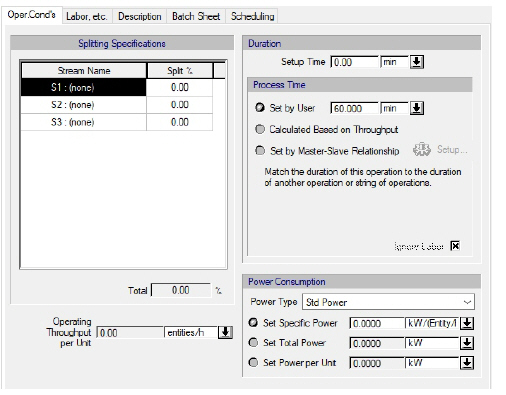

The following table shows a brief description of the variables appearing in this tab. The table also displays their default values and their generally acceptable range:
|
Variable |
Default Value |
Range |
|
|
||
|
● Stream Name |
<None> |
Dedicated Output Port |
|
○ Split % |
0.0 |
0 – 100 |
|
● Total (%) |
0.0 |
0 – 100 |
|
● Operating Throughput per Unit (entities/h) |
0.0 |
Positive |
|
○ Setup Time (min) |
0.0 |
Positive |
|
◙ Process Time (min) |
60.0 |
Positive |
|
○ Ignore Labor? |
Yes |
Yes/No |
|
○ Power Type |
<Std Power> |
Any Power Type |
|
◙ Specific Power (kW/(Entity/h)) |
0.0 |
Positive |
|
◙ Total Power (kW) |
0.0 |
Positive |
|
◙ Power Per Unit (kW) |
0.0 |
Positive |
Symbol Key: ○ User-specified value (always input); ● Calculated value (always output); ◙ Sometimes input, sometimes output
The following list describes the available specification choices in this tab; for more details on how these are implemented, see N-Way Splitting Operations (Discrete): Modeling Calculations.
•Splitting Options...
Specify the percentage of total flow that ends up in each output stream.
•Duration Options...
The duration controls appear only if the procedure is in batch mode. In Rating Mode, you can set the process time (and the setup time), allow the process time to be calculated (based on the throughput), or allow the duration to match exactly the duration of another operation either in the same procedure or in another procedure. In Design mode, you must either specify the process time (and the setup time) or allow the duration to match exactly the duration of another operation (either in the same procedure or in another procedure).
If you choose to match the duration of this operation with the duration of another operation, you introduce a master-slave relationship between the two operations. The program will match the setup-time, the process time and the turnaround time of this operation (the ‘slave’) with the corresponding times of the reference operation (the ‘master’ operation). For more on master-slave relationship, see The Scheduling Tab.